Pick up the Best Stonecrop Varieties: From Ground Cover to Containers.
The most grateful plant in your garden, which doesn’t leave you even if it gets less love than the other plants of your garden, it is the stonecrop. They are also known as Sedum. Due to its succulent nature, it can thrive in low-maintenance, harsh, and dry conditions.
Stonecrops are typically used for ground cover, border edging, adding accents to flower beds, green roofs, and many more.
Whether you are designing a vibrant garden or seeking a low-maintenance addition to your landscape, I am going to introduce you to the top Stonecrop varieties, along with a brief guide on planting and caring for them.
Types of Stonecrops
There are around 600 species of stonecrops. So, selecting the right type of stonecrop for an individual can be overwhelming. But don’t worry, I am here to make it easier for you! Below, I have listed the top 10 stonecrop varieties to help you find the perfect one for your unique situation.
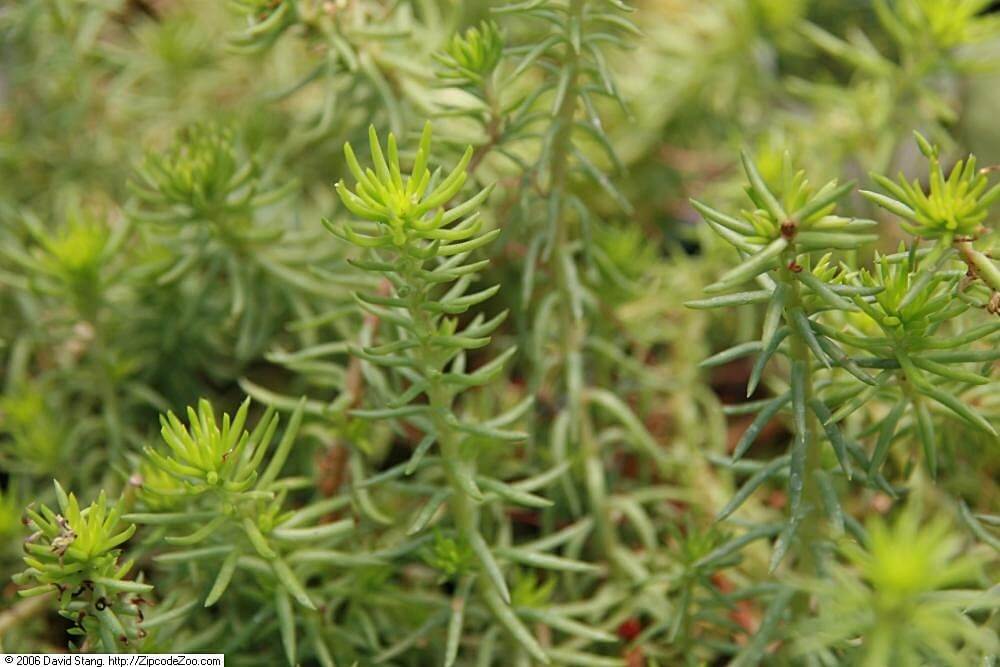
Image by David J. Stang from wikimedia.
1. Sedum ‘Angelina’
The Angelina stonecrop features needle-like leaves and exposes star-shaped flowers during the summer. It quickly covers the ground, by spreading 1-3 feet wide and growing 4-6 inches tall. During autumn, the foliage shifts to a striking golden-orange hue. Though it remains evergreen in moderate climates. Sedum ‘Angelina’ thrives in dry areas and rocky gardens, and full or partial sun exposure is suitable for them.

Image by Leonora (Ellie) from flickr.
2. Autumn Joy (Sedum)
The Autumn Joy is a familiar name in the world of stonecrops. Its flower-show season starts in late summer and lasts till autumn. Yes, you have got it, their name is related to their blooming season.
When they are adorned by blooming, pink-colored flowers, no eyes cannot ignore them, from humans to bees. Besides, their flowers change color as they mature, starting pink, then turning bronze, and finally to deep red. Autumn Joy has a medium growth rate. As well as it can reach up to 2 feet tall and 2 feet wide.

Image by peganum from flickr.
3. Sedum ‘Purple Emperor’
The Sedum Purple Emperor is a popular stonecrop variety among gardeners. They have palm-like foliage and pink-colored flowers. The purple Emperor adorns itself for about three months during the blooming season.
The S.P.E grows 12 inches tall and 15 inches wide. A good amount of sunlight and low moisture is suitable climate for it to thrive. Sedum ‘Purple Emperor’ is also rabbit and deer-resistant. Low maintenance won’t affect its thriving.
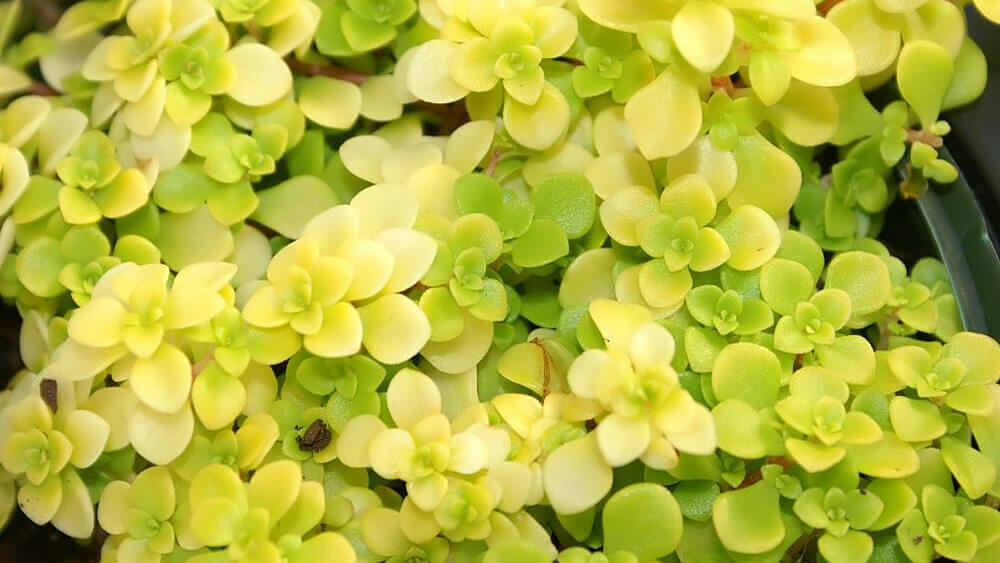
Image by David J. Stang from Wikimedia.
4. Sedum ‘Ogon’
The Sedum ‘Ogon’s glossy, rounded, gold-colored, fleshy foliage gives it a cute appearance. It can grow till 3 inches in height and 12 inches in width. With its slow-growing rate and dense mat-forming tendency, Sedum ‘Ogon’ is a good choice for ground cover.
In summer’s blooming season, the star of the sky seems to take a place on Ogon’s branch. The Sedum ‘Ogon’ grows best in full to partial sunlight, dry to medium moisture, and well-drained soil. While it can endure drought and heat, it cannot endure extreme cold.
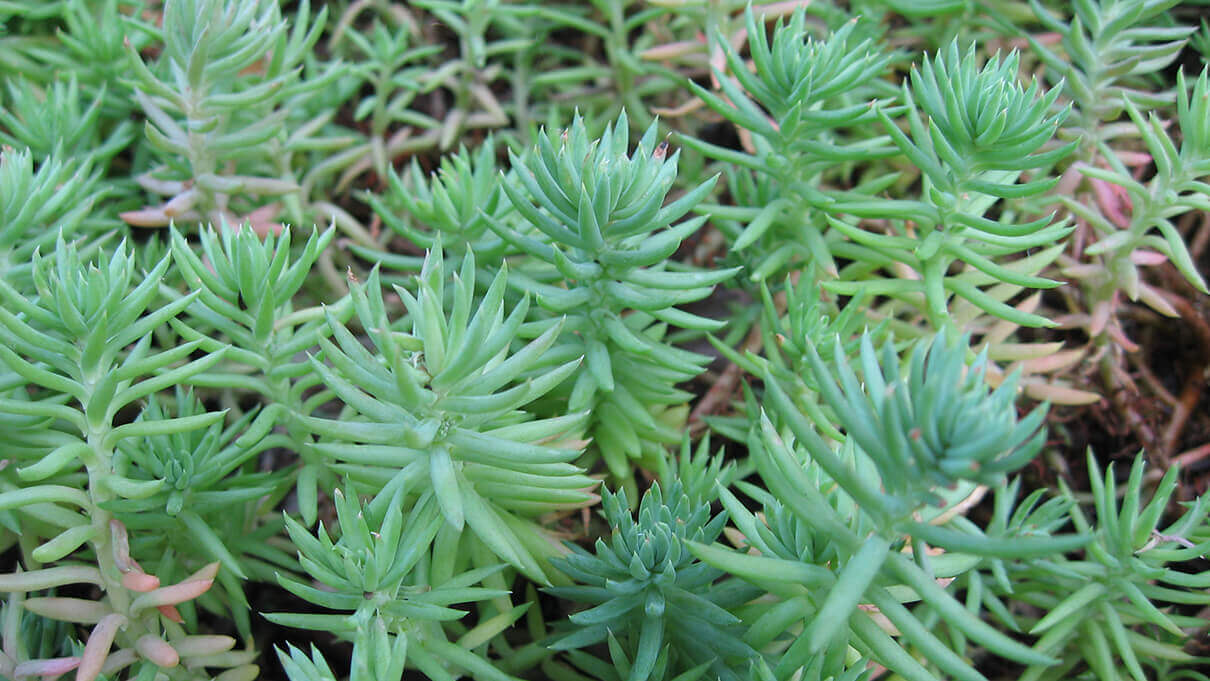
Image by Liné1 from Wikimedia.
5. Sedum ‘Blue Spruce’
The Sedum ‘Blue Spruce’ is a fast growing, low-maintenance stonecrop that is ideal for ground cover. It got its name for its bluish, needle-like foliage. Blue Spruce small yellow flowers bloom in mid-to-late summer. It can grow 6-8 inches tall and spread 10-25 inches wide. Full to partial sun and dry to mid-humid climate is their best thriving condition.
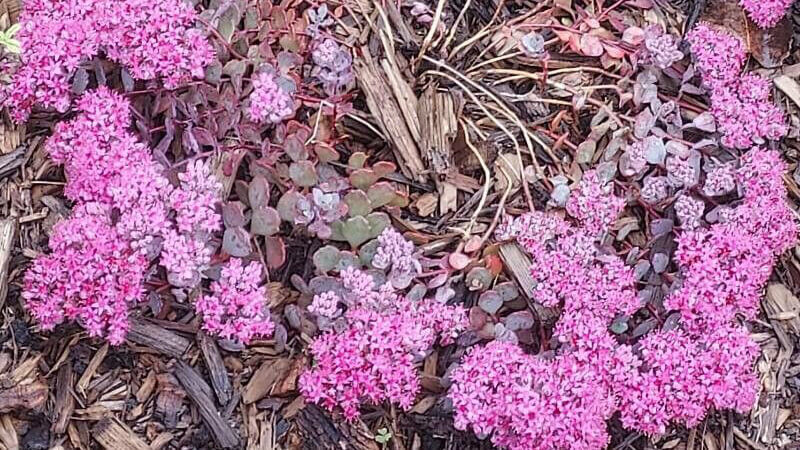
6. October Daphne (Hylotelephium Sieboldii)
Those who have nurtured the October Daphne know it has a unique way of attracting throughout the year by exhibiting different colors. In spring, its leaf displays blue-green, in the heat of summer, the leaf edges turn pink. Additionally, in fall, its foliage transforms into bright orange-red, while pink-bloomed flowers add extra charm to their beauty.
The Hylotelephium Sieboldii is native to Japan. This variety is easy to care for and grows slowly, generally reaching 5-10 inches in height and 11-18 inches in wide.
It’s become drought tolerant once it matures and adapts well to the local climate. The October Daphne also likes full sun to partial shade and moderate moist conditions.
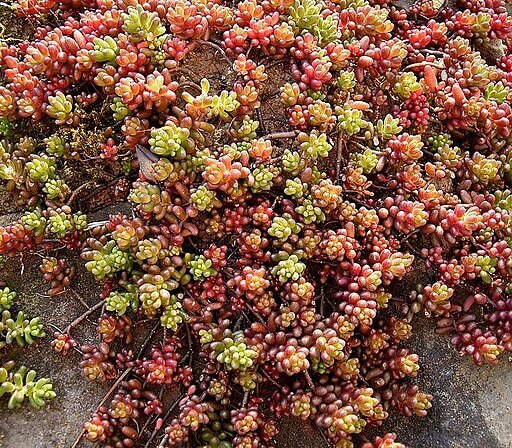
Image by Frank Vincentz from Wikimedia.
7. Coral Carpet Sedum.
The Coral Carpet Sedum has a little bit of color-changing features like October Daphne. When it is small, its foliage is coral-colored, and turns bright green when it is matured. In summer, it deepens to dark green, gradually shifting to fiery crimson in fall and remains fiery crimson in winter.
The Coral Carpet Sedum’s white to pale pink flowers bloom in early summer. It can raise 3-6 inches tall and can spread up to 25 inches. Like many other stonecrop varieties mentioned in this article, this variety is also low-maintenance and forms an excellent ground cover.
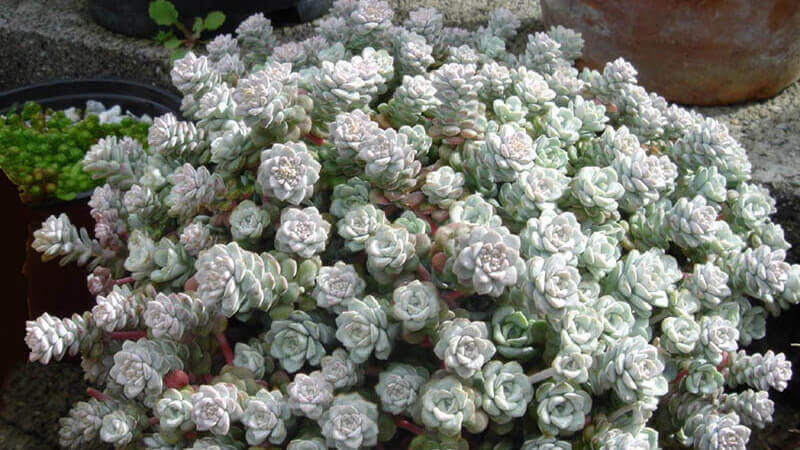
Image by Ghislain118 from Wikimedia.
8. Cape Blanco Stonecrop
This Perennial Stonecrop has silver-blue-colored thick foliage. In summer, it produces clusters of tiny yellow flowers and those flowers become a frequent destination for butterflies.
Cape Blanco Stonecrop is generally used in rocky gardens, as ground cover, and as a container plant. This type of stonecrop can grow up to 4-6 inches tall and spread 8-12 inches wide.
Cape Blanco’s Ideal condition to flourish is full to partial sun exposure, dry to moderate moisture, and well-drained soils.
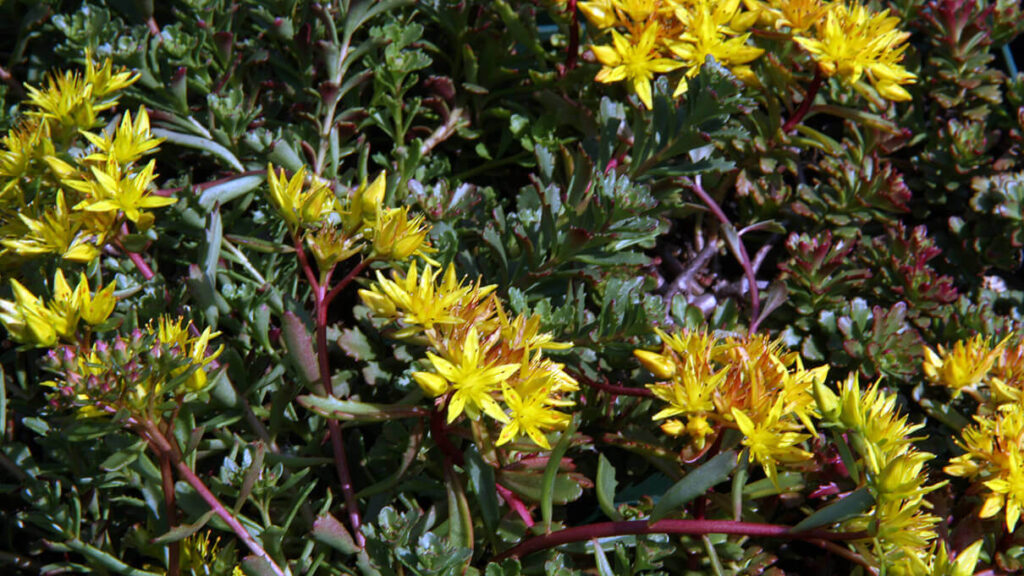
9. Weihenstephaner Gold Orange Stonecrop
The perennial W.G.O stonecrop holds narrow spoon-shaped green foliage. Its yellow cluster flowers bloom from June to August, and then it surprises by producing tiny reddish fruits. This low-growing variety can reach up to 6 inches tall and spread 7-10 inches wide.
W.G.O Stonecrop is commonly used as groundcover, in containers, flower beds, and on green roofs. Like many other varieties on this list, it thrives in full to partial sun, with dry to medium moisture and well-drained soil.
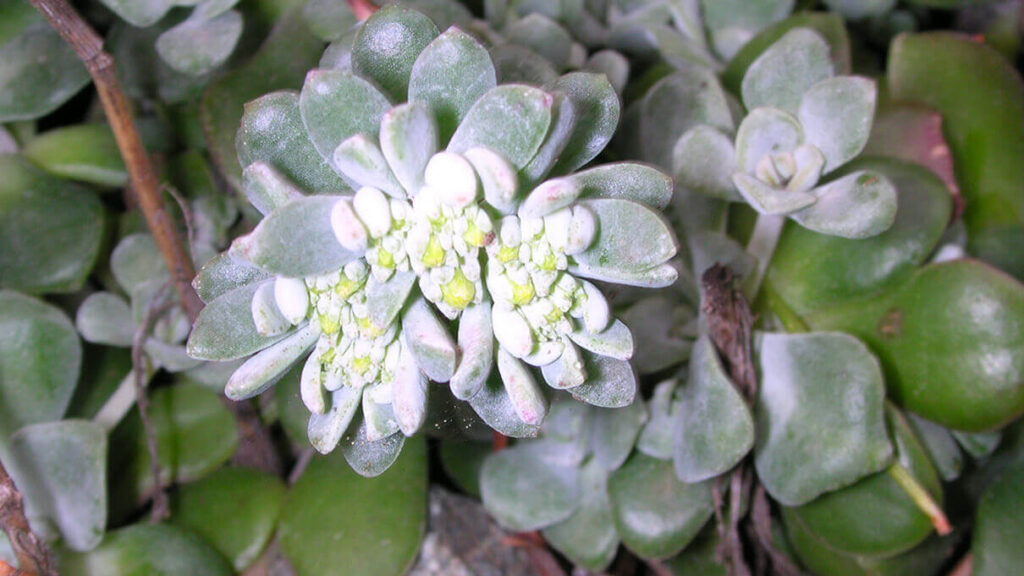
Image by brewbooks from Wikimedia.
10. Broadleaf Stonecrop
At 10th place in this article, Broadleaf Stonecrop has earned its spot. Though it comes last place in this article, you should consider this variety. Because it has quality.
At first glance, you might mistake it for a silver-colored rose, as its leaves form a rose-like structure. Its foliage ranges from silver to blue-green, which changes to purple in winter.
Broadleaf Stonecrop blooms yellow stars in summer that attract butterflies. It needs low maintenance and grows 4-8 inches tall and 14-34 inches wide. This stonecrop breeds also like full to partial sun, with dry to medium moisture and well-drained soil.
How to Plant, Grow, and Care Stonecrop
- Planting method: First, you need to choose a planting method. There are two main ways to plant Stonecrop: seed sowing and propagation.
- Climate & Sunlight: Generally, most of the stonecrops prefer warm and dry climates. Besides full sunlight is ideal (at least 5-6 hours daily) for them, some varieties also tolerate partial shade.
- Soil: Gravelly or loose sandy soil is suitable for their growth. Additionally, don’t forget to ensure a good drainage system.
- Watering: In the first year of planting, water regularly to grow their root adequately. Once they are well-grown, they become drought tolerant. (Note: Over-moisture causes root rotting)
- Puring: Remove disease or broken stems. Occasional pruning helps bushier growth.
- Fertilizer: Typically, Stonecrops thrive in poor soil. It is better not to use fertilizer because over-fertilization leads to weak growth.
- Container: To grow Stonecrop in a container, place the container in full sun, use minimal fertilizer, and water moderately. Ensure that their roots do not rot due to high moisture.
FAQ About Stonecrop
- Is Stonecrop safe for cats, dogs, and chickens?
Most stonecrop varieties are safe for dogs and cats, but some can cause mild toxicity if eaten in large quantities (vomiting, diarrhea, and drooling). However, stonecrops are rarely eaten by dogs and cats, as they tend to avoid the plant. And this is also true for chickens.
- Is Stonecrop deer and rabbits resistant?
Stonecrops are generally unattractive to deer and rabbits. They prefer to avoid it in most cases.
- Does Stonecrops create resistance for other plants?
Yes, some varieties of Stonecrop create resistance to the growth of other small plants and weeds.


